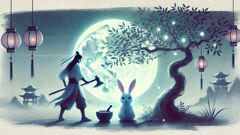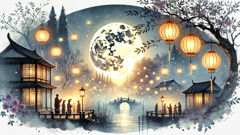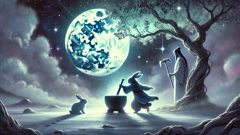Introduction
On clear autumn nights in villages and cities that fold themselves around rivers and hills, people lift their faces and search the moon as if reading a beloved friend's letter. The pale disc is never merely an orb of stone and dust; it is a stitched canvas of shadows, a map of myths and memory. For countless generations in China and across East Asia, the moon has worn many faces—a hare at work with a mortar and pestle, Chang'e alone in her silver palace, a woodcutter forever chopping a laurel tree. These figures are not distant curiosities. They are companions to the living: likenesses pressed to the dark like thumbprints of longing, consolation, and wonder. This story reaches back into that soft light to tell a companion tale: how the Jade Rabbit, whose steady paws pound the elixir of life, came to share the lunar stage with a man whose labor was both punishment and devotion. In weaving the two together—the rabbit who turns medicine into movement and the woodcutter who turns a blade into rhythm—we find a narrative of friendship that threads across ritual lanterns, tea tables, family altars, and the Mid-Autumn Festival mooncakes passed from hand to hand. It is a tale of mistake and mercy, of loneliness and company, of time turned into a kind of living. Here, under the moon that watches the same seas and terraces night after night, the story will unfold like porcelain opening to reveal an inner painting: delicate, enduring, and luminous.
Origins of the Moon's Company: Chang'e, the Jade Rabbit, and Wu Gang
Some stories begin with longing, and others with a mistake; this one begins with both. Long ago, when gods and mortals still leaned close enough to hear each other's voices, there was a mortal named Wu Gang who sought more than his life could offer. A simple woodcutter by trade, he wanted the secrets of immortality so fiercely that he trespassed the gentle bounds between human desire and celestial law. In another telling, Chang'e, the gentle moon goddess, does not seek solitude by whim but by accident—drawn to a potion that promised extension of life, to a choice that cost her home. And by the same faintly luminous thread, the Jade Rabbit had been a creature of kindness, a companion of mortals and spirits alike, whose heart made medicine from myth.

Under the old oaks and beside the river terraces, people told of how Chang'e made her fateful decision. Sometimes it is the jealous stroke of a friend, sometimes the lone impulse of a woman protecting a precious draught. What is constant is the hollow that decision left: the palace on the moon, a wide-brimmed loneliness, and the company that would grow there like moss. The Jade Rabbit appears next in the story not by decree but by inclination. A creature of forest and field, the rabbit had once been mortal, or so the storytellers say, and had learned the healing ways of plants by watching village healers mend fevered children and old grandfathers. When Chang'e fled or rose to the moon, a sanctuary was needed. The rabbit ascended, or perhaps it was carried, and took its place, pounding with steady paws the mortar of the cosmos. The elixir that whisperers speak of is not always merely immortality; it is sometimes the alchemy of comfort, the slow dissolution of loneliness into purpose as the rabbit transformed roots and moonflowers into medicine.
Then there is Wu Gang. His presence on the moon is a kind of cosmic sentence rendered with a soft, inescapable justice. In the oldest versions, Wu Gang was punished for an irreverent crime against the gods—a theft, a challenge, an unquiet ambition—and was told that his atonement would be endless labor. He would chop a laurel tree with an axe, and each time the tree healed itself as freshly as a dawn, his task would return. On the moon he became the rhythm of persistence: chop, watch the tree knit, chop again. Yet even punishment can become company, and over cycles of nights the hedged loneliness of Chang'e softened into shared ritual with the rabbit and the woodcutter. They were not friends at first; they were silhouettes placed by fate on the same bright stone. Over the course of seasons, the moon's surface learned them both.
It is easy to lose sight of how these myths live inside ordinary life. They leak into festivals like water into soil. At the Mid-Autumn Festival, lantern-bearers and families lift their faces toward the same faces of the moon—the rabbit, the goddess, the woodcutter—and children ask with fresh curiosity why there are figures there at all. The elders answer with story, and as the story circulates, it shapes not only the way the moon looks but the way people look at each other. The Jade Rabbit beating the elixir of life becomes a symbol of care: medicine made not for the selfish prolonging of breath but for the tending of others. Wu Gang's unending chop turns into an admonition and a consolation alike: be careful of desires that eat whole, but also know that labor can become meaning if you let it. Chang'e's exile is the sternest of reminders that one choice can change the shapes of many lives.
Yet myths shift and accrete. In some coastal villages, fishermen say the rabbit pounds rice cakes to feed the spirits of the sea. In mountainous temples, abbots say that the mortar on the moon grinds compassion into being. A thousand variations ripple outward, but they are all braided by a common light: the moon as a place where loneliness is made into ritual and punishment finds fellowship. When lovers write poems and brush them into lanterns that float like small moons upon still water, they are performing the most human of acts: making a private myth public. The Jade Rabbit and the man on the moon become more than figures on an orb; they become mirrors.
If you stand by a river during a mid-autumn evening, you can watch the way the moon becomes a vessel for memory. An old woman in a bamboo basket remembers the recipes her own grandmother used for mooncakes and tells the children that the rabbit's pounding is the rhythm by which sweetness returns to the world. A young man, new in town and homesick, finds himself humming the tale as if it were a song that might stitch his longing into a stronger cloth. Each hears the myth not as a distant relic but as a palimpsest—new meanings written over older ones, all legible because everyone reads them aloud.
In the end, the origin stories of Chang'e, the Jade Rabbit, and Wu Gang insist on one necessary human truth: that we read the sky to read ourselves. The creatures and the man on the moon are companions because their stories give shape to emotions we otherwise might not name. The rabbit pounds not only elixir but the possibility of mercy; the woodcutter chops not only a tree but the stubborn knot of regret; Chang'e holds the lonely palace like a fragile lantern that still glows despite distance. When these figures share the moon, they tell us, in a voice as soft as the falling of rice and as steady as the turning of a wheel, that even punishment need not be the end of fellowship and that friendship can be found in the most unlikely of sentences.
How the Moon Teaches: Rituals, Redemption, and the Quiet Work of Friendship
Stories age like lacquer: they darken and gain shine in the parts that are touched most often. From village hearth to imperial court, the image of the moon and its occupants has flowed through countless hands, each shaping it to meet the needs of their time. The tale of the Jade Rabbit and the man on the moon moved, too, from explanation into instruction. It is not only a myth that answers the child's question about the shadows on the moon; it is also an ethics lesson disguised as a folk image. To watch the rabbit is to watch a being who chooses labor for others; to watch Wu Gang is to watch a being who cannot escape the consequence of a single act. Put together, their stories create a moral landscape where companionship is both earned and offered.

Consider the Mid-Autumn Festival, the moment when myth and practice meet under the same wide lantern. Families gather to admire the full moon and to break mooncakes like small, edible altars. In the filling of those cakes there is symbolism that echoes the rabbit's mortar—sweetness mixed with seeds, lotus paste like the soft dead center of a memory, salt and sugar balanced as if by ritual. Parents tell children the story of the Jade Rabbit and the man on the moon as they slice the cakes, and the story becomes instruction: give precious things to others; remember past mistakes; do not let ambition swallow your life whole. As the moon slices itself into the watery reflections on a river, listeners see both figures in the light: the rabbit as embodiment of tending, the woodcutter as a cautionary silhouette.
Yet there is more than moralizing to the moon. There is a way the moon teaches people how to practice forgiveness and to make meaning from repetition. Across many versions, the relationship between the rabbit and Wu Gang shifts from coexistence to gentle comradeship. At first they are only neighbors on the lunar terrain—two silhouettes who happen to occupy the same bright stone. Over time, in certain tellings, they speak. The rabbit pounds and pauses; Wu Gang chops and rests his weight against the laurel trunk. They trade small comforts. Wu Gang presses his palm against the tree and tells the rabbit of villagers he loved and lost, and in response the rabbit grinds a different herb into balm and drops it into the mortar, offering relief in a form the cosmos can hold. The idea that punishment may be mitigated not by erasing consequence but by the presence of company is the peculiar mercy of these myths. In real life, a person cannot undo a past mistake by simply wishing it away, but their burden can be made lighter by another's steady presence.
This slow reciprocity is the lesson that generations have folded into lanterns. A midwife might tell a mother that the Jade Rabbit's work is the model for tending newborns: persistent, quiet, and exactly measured. A teacher might say Wu Gang's labor is a reminder to temper ambition with humility. But in the quiet between instruction and commentary, the story offers something softer: the observation that the moon's figures are not caricatures but companions whose existence acknowledges human solitude. In the way that the Jade Rabbit pounds into night after night, the story insists that repetitive care is itself sacred. In the way that Wu Gang chops and watches the tree knit itself back to life, the tale insists that some penance is not a sentence to be borne alone but a rhythm that can become a shared prayer.
Folk artists have painted these interactions for centuries, and the visual language they developed reinforces the tale's lessons. In temple murals, the rabbit's ears tilt toward the sound of the woodcutter's axe. In scrolls passed down as betrothal gifts, couples are often shown beneath a moon that holds both figures, as if to bless their union with the qualities those figures represent—kindness, endurance, vigilance. The iconography slides easily into family life: mooncakes stamped with rabbits, lanterns painted with small axes and laurel leaves, children learning to fold paper rabbits that will sit on their windowsills during the festival. Each simple object becomes an emissary for the tale's deeper meaning.
Beyond ritual and object there is language. Poets of several dynasties have glanced up and used the moon as a shorthand for the complicated calculus of desire and consequence. They write of the rabbit's diligence as a cure for yearning, of Wu Gang's patience as a method of confession. Through poetry and song the myth bleeds into the texture of daily speech: when someone endures a long, repetitive hardship, an elder may say, "You are like Wu Gang," not to shame but to name. When someone devotes themselves to caring work, they may be called "rabbit-hearted," a compliment of rare warmth.
In contemporary life these stories continue to adapt. City-dwellers on balconies with potted plants place paper lanterns and remember their grandparents' voices telling the tale. Children on screens see stylized rabbits in animation but still ask their parents the same old question: why is the rabbit up there? Families who emigrated keep these images as anchors, and in diaspora the moon becomes a tether that allows memory to cross oceans. Even scientists who study the moon sometimes use the myth as a metaphor when explaining the slow processes of lunar geology to curious youth. The myth's elasticity is part of its power: it can be both a cultural artifact and a living map of human feeling.
Most of all, the story of the Jade Rabbit and the man on the moon sustains one stubborn idea: companionship can be fashioned from repetition and ritual, and friendship may be the quiet work of many small acts. The rabbit pounds the mortar each night, not for glory but because pounding has become the sacred rhythm that keeps the moon from being a lonely place. Wu Gang chops, not because redemption is granted easily, but because the act itself holds meaning as long as he does not stop. Between them a pattern emerges: two lives, different in origin and deed, become companions by simply showing up night after night on the same bright surface. That is a lesson the human world can learn as we gather under lantern-light and share slices of cake: that presence is often the most generous of gifts, and that even punishment can be softened by another's company.
Conclusion
When you lift your eyes to the moon tonight, consider the company it keeps. The Jade Rabbit with its mortar is not merely a symbol of elixir and immortality; it is an emblem of caregiving—small, rhythmic acts that tend the world. Wu Gang, the man in the moon whose axe finds the laurel again and again, is more than punishment: he is a witness to the way consequence can be worn into meaning when labor is sustained. Between them stands Chang'e, holding a palace of light that resembles both refuge and exile. Together they form a constellation of companionship: a mythic lesson that reminds us to read the sky not as a place of solitary wonders but as a mirror for shared lives. In kitchens and courtyards, during lantern festivals and quiet evenings, people fold these stories into the fabric of living—teaching children, guiding lovers, consoling the bereaved. The moon teaches the slow art of keeping one another, and in its gentle, persistent presence we find an answer to the oldest of human questions: how do we stay with one another, across mistake and mercy, across longing and the years? The answer, quietly and luminously, is to show up. To grind and to chop, to wait and to heal, and in small rituals of care become the companions who make solitude bearable. Look up, and let that companionship shine back into your life.













